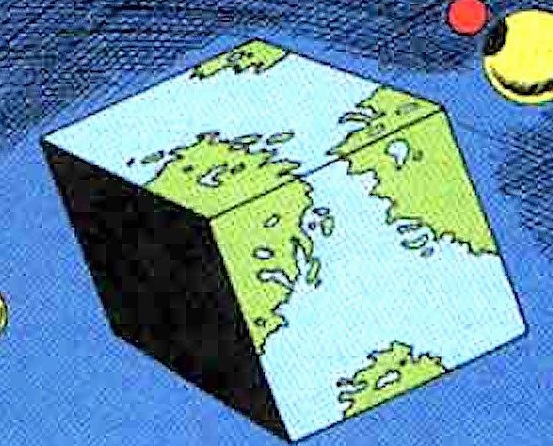B for sure. Consider a long pole (stationary relative to the track) entering the portal at the front of the trolley, it would leave the portal at the speed the trolley is moving.
Yes but it wouldn’t be possessed of any momentum, it only appears to be moving because the train is moving. As soon as it cleared the portal it would drop straight to the ground.
But it gains the momentum when it exits. It’s moving at it exits the blue portal. Meaning it has momentum at the exit point.
Conservation of momentum says B I would think. From the protal’s reference frame, the people are moving fast toward it.
Conservation of momentum would suggest A, otherwise an outside observer would see momentum generated from nowhere right?
The portal is a hole. The hole is moving. The conservation of momentum is the hole moving as it continues to move along the track. If the people start moving, where does that momentum come from?
Imagine a tennis racket with no strings. Two portals are stretched across the space the strings would normally be, back to back, one orange one blue. If you threw a ball in the air as if you were going to serve and swung the racket, the ball would pass straight through the portals as if they weren’t there and would fall straight down due to gravity. The ball maintains its conservation of momentum, and the tennis racket holding the portals also maintains its conservation of momentum as it swings through the air. There is no force applied by a hole.
Lets say the tennis racket has 2 portals. One in the front and one in the back. When you swing the racket, the front portal moves forwards with some speed V. The portal on the back is moving backwards with the same speed, so -V (same speed V, but in opposite direction). A stationary ball, suspended in mid-air would have 0 speed. The racket portal approaches the ball at speed V, so the ball has a relative speed V to the racket. The portal on the back has a speed of -V and ven you combine that with the ball’s speed of V, we get -V+V=0. And so the ball stays put. The portals in the image are not both in motion. The front portal is approaching the people with a speed of V and so the relative speed of the people to the portal is V. The exit portal has a speed of 0, relative to the people. When the people go through the portal, their speed is 0+V=V, meaning they get launched out the exit portal with the same speed the entrance portal hit them.
Interesting way to look at it, but I still dont see where the force is acting on the object going through the portal. The object is not in motion and will stay in that state unless something acts upon it, so where is the energy coming from to act on the object?
To make it clear from the start: I agree 100% with B - there has to be movement, because without it, people wouldn’t come out of the portal at all. And if there is a movement, then the only reasonable speed would be that of the train.
But: Your question about the energy is still interesting. It must come from somewhere. And I think, the only source, from which it can come, is the train. That is, the train would lose energy and therefore slow down.
The portal moves towards the people. It’s a hole. Momentum won’t transfer from nothing as the hole is the one moving.
So, how would the people come out of the portal without movement?
Because the portal is moving them through it
Like how you would move through a hoop if it passed through you, it’s just a door through space
Conservation of momentum is based on Newton’s first law which states “a body at rest tends to stay at rest” so that would imply A. not B.
Those dudes were just chilling, and would still be laying there chilling.
Yeah but the momentum is relative to the portal.
If the blue exit portal was behind the wagon and so moving at the velocity of the orange entry portal, then I would agree that it’s A because they move at the same velocity and in the same direction.
But since the blue exit portal is static and the orange one is moving, the people will enter the portal at a relative velocity to the portal which will be transferred to the blue one. Meaning B will occur.
If the portals were on two wagons going in the opposite directions at the same X velocity, then the people would enter at X relative velocity and exit at 2X velocity.
Right, in perspective of the initial orange portal the people are moving. They aren’t at rest compared to the portal. The portal is at rest.
B. Velocity is relative.
deleted by creator
but relative to what? assuming portals work similarly to windows, if I take a hoop/window and place it quickly over an object, that object won’t launch in the opposite direction
if I take a hoop/window and place it quickly over an object
Then the velocity of the object relative to the “exit” of the hoop would be the same as the velocity of the object relative to the “entrance” of the hoop, which is option B.
In your analogy, option A would mean the object has a relative velocity of entering the hoop but suddenly no relative velocity exiting it, so the object magically starts following the hoop.
that’s true relative to the hoop, but relative to the ground the velocity would stay zero. otherwise, relative to the ground, the object would gain velocity without any force being applied to it.
Technically, relative to the ground the object becomes moving infinitely fast as soon as it enters the portal. I think a more intuitive answer can be found by replacing a nice discrete object like a box or group of people with a long pole that enters the portal lengthwise. Obviously, it’s going to have to be exiting the other portal at whatever speed the first portal is moving. The out speed should always be the same as the relative speed of the object to the entrance portal, it’s the only thing that makes sense, and also the only way to appease conservation of momentum.
Yeah, but that’s because both sides of the window are traveling at the same speed. If the blue portal was on the other end of the tram, they’d plop.
If you strap a camera to the window, it will appear as if the object launches from the camera’s perspective.
“Velocity is relative” doesn’t really apply here. The question is momentum, the pedestrians have none, the portal will pass right around them. Imagine the exit portal is on the back of the train, it would be as if a large hollow tube was passing around the pedestrians, they would still be laying there stationary.
Momentum is relative too, since it’s equal to mass times velocity (in classical mechanics, of course)
deleted by creator
Neither, portals aren’t real
Or either, portals aren’t real.
there’s a video with a great explaination about this: https://youtu.be/B19nlhbA7-E
Also this one!
“I rewrote Portal from scratch and solved the Portal Paradox”
Here is an alternative Piped link(s): https://piped.video/ao1qVi5Qp3Y
Piped is a privacy-respecting open-source alternative frontend to YouTube.
I’m open-source, check me out at GitHub.
Here is an alternative Piped link(s): https://piped.video/B19nlhbA7-E
Piped is a privacy-respecting open-source alternative frontend to YouTube.
I’m open-source, check me out at GitHub.
What in the world is going on in this image?
Portal themed morality decision test meme.
Ohhh now I see the portals
Portal would fail due to being placed on moving object
Except for that one section in Portal 2 /s
Why the
/s?It’s true. Obviously it makes for simpler puzzle design plus was easier to ignore the full capability (even the version in 2 seems to just work enough to allow the set-piece), so it seems silly to use developer limitation as a gotcha.
The world is moving, checkmate.
It’s all relative.
Tell that to einstein
Oh wait
I would imagine that the relative motion between the entry/exit portal would be more important than the absolute motion of the two portals.
Portal 2 ends with you (Chell) placing a entry portal on Earth vs an exit portal on the Moon.
That means the portals were ~2236 mph (aka Mach3) relative to each other.
Wouldn’t that provoke all air in the Earth to get sucked to the Moon due to the difference in atmospheric pressure?
Yes, but the flow rate is only so much. It was only open for a short time before Glados closed it.
Vacuum doesn’t suck. The atmosphere on Earth would push air through the portal with a pressure of about 1 bar.
Hmm well if an object passed through that portal and it wasn’t moving ~2236mph relative to the surface of the moon, then I guess the question from the OP has been answered already haha.
So if portals didn’t have a distance maximum, assuming that they twist through some higher dimension or into an alternate universe and back or something like that, it would make sense that you could open a portal on Earth and on Mars and anything you push through that portal would maintain its velocity relative to Earth.
Which could result in some hilarious events where things basically detonate the instant they are pushed through as they are slammed into the surface of Mars at potentially ten of thousands of miles an hour depending on the Earths and Mars’ relative velocities.
Despite that, there would also undoubtedly be times where their velocities synchronize due to their varying rotational locations and orbital velocities around the solar system, during which times you could conceivably quite easily step from Earth to Mars in a single go.
The safe thing to do though would be to decant from the Earth into a portal that is in orbit around Mars far enough away that at the worst you would experience some relatively gentle abrasion from the smattering of hydrogen atoms in the space surrounding Mars and then parachute down from orbit.
This reminds me of when somebody set up the Trolley Problem for their toddler with those little wooden toy trains. The kid put the one guy on the track with the several guys and then plowed through all of them with glee.
The only way it could be B in this universe is if the train also decelerates equivalent to how the people accelerate. If the people accelerate and the train maintains velocity you’ve created energy in a closed system.
Objects coming out of the portal in “a” have to have velocity coming out (they don’t magically appear outside of the portal, they move out inch by inch/ cm by cm). So in a you would actually have double the deceleration on the train because it has to accelerate people leaving the portal and then instantly decelerate them once they have fully exited the portal.
Portals don’t abide by the laws of physics. Portal above + portal below = infinitely falling object (and thus infinite kinetic energy)
Portals don’t abide by physics, but people still do. Even in the infinite fall scenario there isn’t infinite energy because the object accelerating is still subject to terminal velocity, and it’s change in momentum comes from gravity. For the people to change their velocity, there has to be energy imparted onto them. My theory is that the train would have to slow.
The issue with being able to get infinite amounts of energy out of a portal can be solved by thinking with entropy.
If you only look at the entropic system of the portal and the object falling through it, say for instance a magnet inside of a vacuum tube that is perfectly abutted to both ends of the portal, the energy that you are able to extract from the system using a set of coils would come from gravity, and that gravity energy would come from the Earth.
In that case, one of two things would have to happen, either the mass of the Earth would decrease by being converted into energy, or two, the amount of energy needed to maintain the portal would be equal to or greater than the amount of energy that you’re capable of extracting from it with an infinitely falling magnet and coil.
I think that the tram would not have to slow down, and that there would be no additional momentum added to the victims as they pass through the portal, and any energy that is lost in those two equations would come from the energy needed to maintain the portals operation.
I think that the tram would not have to slow down, and that there would be no additional momentum added to the victims as they pass through the portal
So scenario A?
Yep. I’ve been advocating A since the beginning
You see, shit like this is why I love theoretical discussions about impossible crap. Somewhere else in this thread we use the idea that a moving portal can impart momentum in combination with the idea that portals need to maintain a minimum energy level to explain why moving portals collapse in a way that would at least be satisfying to someone reading a sci-fi novel. It’s now my head canon.
C. A train flies out of the blue portal
A, the people are traveling towards the portal, not the other way around.
If they were falling/running at the portal it would be different.
Here the portal is moving forward towards them, they have no momentum.tk travel through the portal.
i still can’t believe people think it’s A
Portal 2 even had sloped portal surfaces. Technically it’s not a or b but b is the closest.
But the orange portal is moving. The game code works more like A (it bugs out and the object bounces off the portal surface, but it uses a world-fixed coordinate frame that would match A for behavior). A (Newtonian) relativistic coordinate system would match B. For everything with non-moving portals A & B are equivalent.
The game code works more like A (it bugs out and the object bounces off the portal surface, but it uses a world-fixed coordinate frame that would match A for behavior).
Ah, I see what you are saying. They apply the velocity of the object again after teleporting rather than the difference between the velocities of the portal and the object. Thus the velocity of the train would be ignored. Well, B is wrong simply because the game engine doesn’t rotate characters in the teleport because that would ruin character physics. So B is wrong twice.
Yeah, most game engines like Portal’s uses absolute speed relative to the coordinate system (which doesn’t change when the coordinate values change), in addition Portal technically doesn’t actually implement “wormhole type” portals and instead superimpose a clone of the polygons near both portals behind the other (to preserve expected object collision behavior around the portal) plus doing tricks with virtual cameras, so if you fixed the bugs with moving portals then it would be A.
But if you implemented proper relativistic physics with proper wormhole type portals you’d get B.
Do you even portal, bro?
I think it’s A because I assume a portal stitches two points in space to each other.
So if I have a surface A and B with a portal ‘]’ in the middle A0 A1 ] A2 A3. B0 B1 [ B2 B3
A portal creates a new surface
A0 A1 ][ B2 B3
And if you move the portal the new surface changes.
A0 A1 A2 ][ B3
Speed is distance over time. When a portal moves the object that passed through the portal stays stationary. Let’s say I am standing on B2. When the portal advances I find myself standing on A2 , have i moved? No the environment has changed but i am still in the same relative position with respect to the portal surface. No distance travelled so no speed.
I say its B, because if we jump in a portal we fly out of the other one. Now the difference is here the portal is moving and not the person, but in physics we are only interested in the motion of two bodys relative to each other. If you are standing on the train you would see the portal as stationary and the people coming towards it. Because the object/person enters the portal with speed it also comes out with the same speed.
If you jump into a portal, YOU have momentum, these people are stationary and therefore have no momentum, the answer is A.
There is no momentum without saying relative to what. A train is moving relative to the people not on the train. The earth is moving relative to the sun. But if you are on earth the sun is moving and you are stationary and your viewpoint is not wrong! The reason is, that there is no underlying space we are moving relative to. Maybe this helps: Imagine a train in a train. Driving with the same speed but in the opposite direction. Now from the outside the inner train is not moving at all, but the outer train is. From the inside the inner train is moving and the world around them is. If there is now a portal inside the outer train and the inside train is passing through. What happens. Nothing because the inside train is not moving or it shoots out because it is moving?
The portal is a connection of two spaces, but the spaces themselves are not moving. It’s hard to say though because some sort of force would have to push you into place, but momentum is conserved so… Who knows.
But the object doesn’t enter at speed here it’s stationary. If a hoop is thrown at an object and passes around the object the object is still stationary. The speed of the portal relative to the object does not impart movement on the object.
The quicker the portal moves the quicker the object appears on the other side but for the object to shoot out it means energy is being transfered from the car to the object.
If you’re right then what happens If the two portals are moving at equal and opposite speeds?
B.
Speedy thing goes in. Speedy thing comes out.
Although it kind of depends how fast the tram is going.
You mean A. The people are not speedy things, they are stationary things.
The whole thing would just be relative to the portal, though. Relative to the portal, they come in fast and out fast.
Not relative to the train. From the trains perspective, they are moving towards the train with the same speed they see the train moving.
There is no single correct reference frame. All reference frames are equally correct. If you want to argue that something is stationary, you have to explain what it is stationary relative to. There is no absolute “stationary”.
Absolutely correct. We learn this in basic static as dynamic physics.
The people are possessed of no kinetic energy, the train cannot physically act upon the people since the portal is intangible. There’s no way for the train to transfer any kinetic energy to the people, and there’s no other force that could act on the people. No kinetic energy going in = no kinetic energy coming out.
From the perspective of the train, the people have just as much kinetic energy as the people think the train has. Again, you’re acting as if there is one absolute frame of reference - there isn’t. Physics just doesn’t work the way you think.
This is why all your comments in this thread are wrong, they have one simple logical issue: the people on the tracks aren’t “stationary”. They are stationary to the ground, but not to the train. It’s not correct to say “the train is moving and the people are stationary”, because it’s also just as correct to say “the people are moving and the train is stationary”. Physically both are true at the same time, that’s what general relativity is really about. You can’t look at the scene and decide “only one reference frame is valid”, that would break all of physics.
deleted by creator
If we assume portals obey https://en.wikipedia.org/wiki/Galilean_invariance, then there’s no difference between “the tram|portal is moving and the people are stationary” and “the tram|portal is stationary and the people are moving.” The outcome should be the same.
No, the speed of the pedestrians relative to the portal is not zero.
But the pedestrians have no momentum, only the portal has momentum.
Replace the portal with a normal open doorway, or that gameshow “hole in the wall”, when someone passes through the hole, they aren’t launched out of the other side, they’re still just standing there as the door passes around them.
They have momentum though. They’re on the earth (presumably), which is yeeting through space at a rapid pace. Portals must respect relative speed, otherwise everything would fly out due to their speed.
deleted by creator
No your wording was correct, do not apologize.
deleted by creator

















